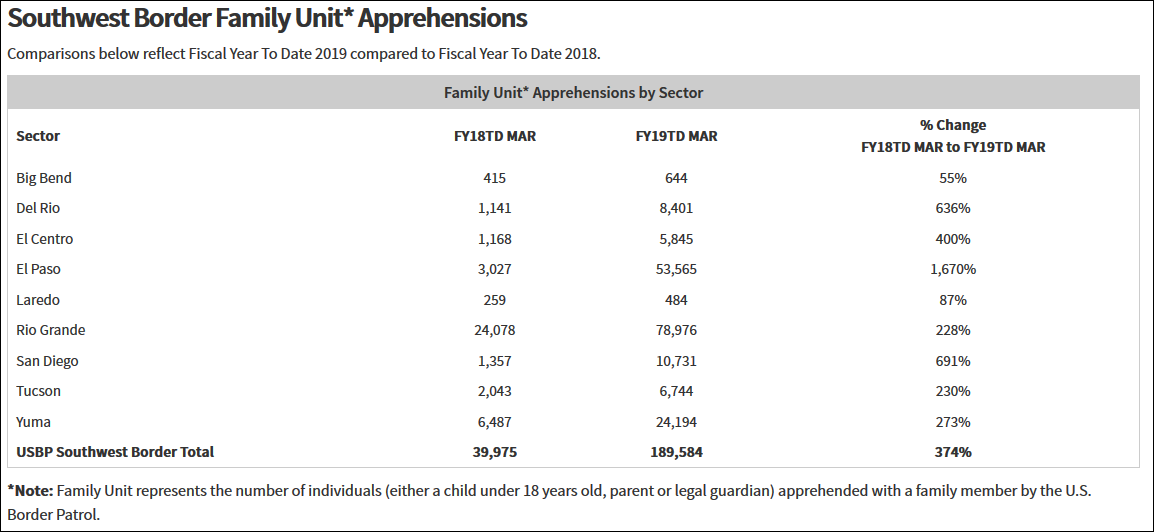The cost to care for illegal immigrants streaming across the U.S.-Mexico border is rising exponentially, with spending on food, diapers, and medical care expected to his $1.2 million in one sector alone for fiscal year 2019.
Justin Kallinger, spokesman for U.S. Border Patrol’s Yuma Sector, told the Washington Examiner agents there expect to spend four times as much on basics to care for illegal immigrants this year than they did in fiscal year 2018, when the total cost came to about $300,000.
“As of March 31, the halfway point into fiscal 2019, the sector had spent $600,000 in those same items and services,” according to the news site. “It now expects to hit $1.2 million by Sept. 30…”
The Yuma sector is one of nine different sectors protecting the border, and it’s third among them in the number apprehensions of illegal immigrants with children. Yuma is also the only city along the border to declare a state of emergency because of the large surges of illegal immigrants, which cost local taxpayers $700,000 for emergency medical services last year.
In March alone, Customs and Border Protection data shows the Yuma sector recorded the apprehension of 6,620 “family units” – or illegal immigrants traveling with children, following behind the Rio Grande and El Paso sectors, which recorded 20,962 and 16,884, respectively.
“In 2014, I believe, only one percent was single males with children,” one Border Patrol official recently told KGBT. “Now it’s up to 50 percent.”
The reason is simple: The sheer numbers of illegal immigrants crossing the border is overwhelming government processing centers, forcing officials to release so-called family units immediately after processing.
In recent months, the government has dropped them at homeless shelters and bus stations with a court date to appear for an immigration hearing months in the future, though the vast majority never return.
#BORDERNEWS Immigrants tell me they’re coming to the U.S. because they’re seeing advertisements on their local newspapers and TV stations, about better opportunities and free help from Americans if they enter illegally. My #Exclusive report straight from the border. #Immigration pic.twitter.com/mpRdg2hes7
— Sydney Hernandez (@SydneyKGBT) April 15, 2019
Several migrants who trekked through Mexico from Central America told KGBT’s Sydney Hernandez that television and newspaper ads in their home countries tout the “free” stuff for those who can make it across the border, where they will find help and jobs.
Kallinger explained why the situation now is different than in the past, when Border Patrol was mostly dealing with Mexicans sneaking across the border in high numbers. Then, the single men could be processed and departed in the same day.
“These people are not from a contiguous country (Mexico or Canada), so we can’t just take them back. Their cases have to be adjudicated,” he told the Examiner. “At a certain point, we can’t just hold them in our facilities anymore.”
Three Border Patrol stations in the area hold about 400 people each, and the agency has pushed the limit, but agents are arresting up to 350 illegal immigrants a day, Kallinger said.
Many are well aware that if they bring a minor along with them, they’ll skip to the front of the line to be released, whether or not they’re claims for asylum legitimate.
Kudos to Chris Cuomo for revealing that what’s driving illegal immigration from Central America are job opportunities in U.S. and asylum loopholes. Very few have legitimate credible fear claims. This is how reporting is done.
Congress continues to allow this crisis to build. pic.twitter.com/iqaIjzuVTR
— NumbersUSA (@NumbersUSA) April 3, 2019
CNN’s Chris Cuomo had a conversation with one illegal immigrant through an interpreter who explained the situation.
“Is he here to work, or is he here for asylum?” Cuomo asked.
“He wants to work, but if he gets asylum, he’s willing to ask for asylum,” the interpreter said.
“Why did he take his kid to come here if it’s just to work?” Cuomo pressed.
“It’s what you and I were talking about,” the interpreter replied. “He said that if he comes here with his son then he’s allowed to stay.”
Leave a Comment
COMMENTS POLICY: We have no tolerance for messages of violence, racism, vulgarity, obscenity or other such discourteous behavior. Thank you for contributing to a respectful and useful online dialogue.